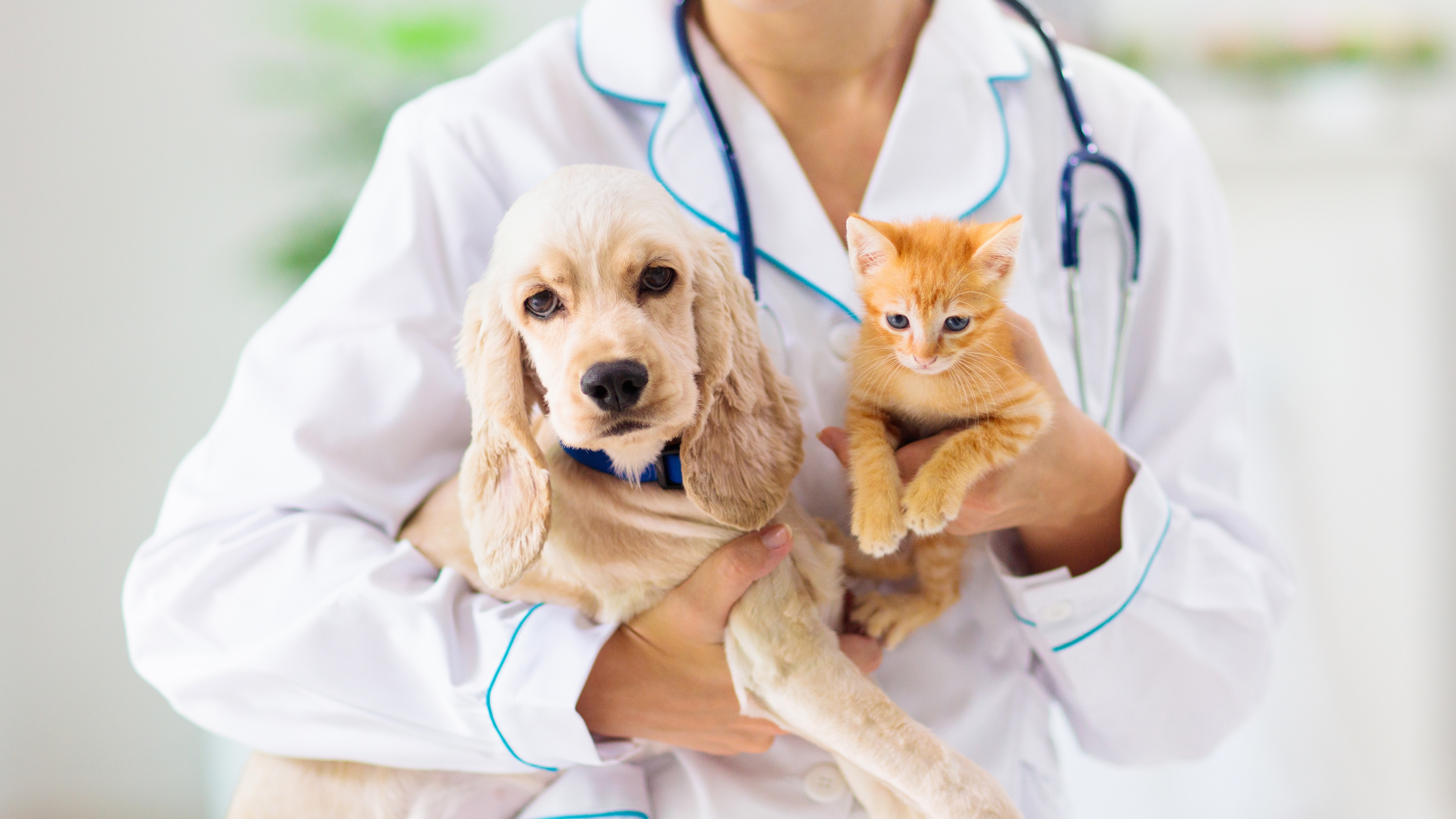Published July 15, 2024 • 7 Min Read
Before adopting a pet, it pays to be aware of some hidden costs of pet ownership — from initial adoption to the final farewell.
TLDR
-
Pets bring plenty of fun, joy, and love into life but can also be a significant financial responsibility
-
There are many expenses to caring for an animal that first-time pet owners may not have thought about
-
Before adopting a pet, consider from adoption fees, licensing, and day-to-day care to veterinary expenses and additional costs — and if your budget can cover them
Buying or adopting a pet can be a rewarding experience. Inviting a pet into your family does come with physical and emotional benefits.
Owning a pet, however, can often have hidden costs beyond those initial fees, so it’s important to be financially prepared before committing. From upfront costs to insurance and vet visits, here are some commonly overlooked costs of pet ownership.
The upfront costs of pet ownership
A purebred dog from a reputable breeder in Canada can cost between $1000 and $5000 — and sometimes more, depending on the dog’s size and breed. If you choose to go to a cat breeder, you may pay $500 to upwards of $3500.
And if the breeder lives far away, you may have to factor in the transportation costs to get your new family member.
If the breeder hasn’t vaccinated, dewormed, microchipped and treated the animal for fleas and ticks, you’ll have to cover these expenses yourself. Chances are your new puppy or kitten isn’t yet spayed or neutered, so unless you plan on letting them have a litter or two, you’ll also need to include this procedure in your budget.
Shelters and rescue groups often charge adoption fees; however, these tend to be lower and typically cover the cost of an initial veterinary exam, spay/neuter surgery, vaccinations, and flea, tick and heartworm treatments.
Many Canadian municipalities require people to licence their dogs and cats (even indoor cats) at adoption. This is an initial and ongoing cost, as the licence must be renewed yearly. Dog licences are more expensive than cat licences but may qualify for a discount.
You’ll also need certain supplies and equipment for your pet’s care and comfort, like food and water bowls, leashes and collars, grooming brushes, winter coats, bedding, toys, crates or carriers, scoop bags, kitty litter and litter boxes. Also, keep in mind that puppies and young dogs may need basic obedience training, so if you’re unable to train them yourself, you’ll want to add this cost to your budget.
Money-saving tips for upfront costs
If you want to save money on the upfront costs of pet ownership, there are a few alternative options to traditional pet adoption and ownership:
-
Adopt an older pet: There are many upsides of adopting an older dog or cat, including the fact they’re already house-broken, litter trained, know their basic commands and are a shorter-term cost commitment since they’re already many years into their lives.
-
Rehome a pet: Many people must give up a pet for reasons beyond their control, such as allergies, illness, or a disability, and they may be able to offer their pet for free if it is given to a good home. This can not only cost less money than traditional ownership, but you’re also giving that pet a second chance at having a good home.
Ongoing costs of owning a pet
Now that your pet is home and your supplies are in place, there are ongoing costs to consider, including food (the larger the animal, the higher the food bill), cat litter, grooming costs, dog and cat treats, routine and emergency vet visits and annual license fees not to mention the ever-increasing costs of annual medications such as flea and tick pills. If you’re working during the day, you may also need to factor in doggie daycare, dogsitter or dogwalker expenses.
Some active breeds, like border collies, need a lot of physical activity and may benefit from agility training or herding to prevent boredom. If you cannot do this yourself, consider including ongoing training in your annual budget.
Money-saving tips for ongoing costs
Owning a pet requires a lot of maintenance costs that can add up over time. If you’re concerned about the amount of ongoing expenses, there are a few options for reducing them:
-
Consider alternatives to pet toys: An old tennis ball or stick can be perfect for pets who play fetch. Cats often engage with homemade toys as readily as pricey, store-bought ones, so consider a simple paper bag, cardboard box or some catnip to keep them amused.
-
Search for rewards programs and discounts: Many local pet supply stores offer customer rewards programs or senior discounts, so take advantage of their cost-saving opportunities.
The often-overlooked costs of pet ownership
Aside from the day-to-day costs of having a pet, there are additional costs, such as vacation, moving, illness, accidents and vet emergencies. When travelling, you’ll have to consider the costs of hiring a pet sitter, boarding your animal in a kennel, or bringing your pet. If you’re travelling with your pet, there are a few cost considerations, depending on how you plan to travel and where you’ll be staying — at a campground, with family and friends or in a hotel.
If your animal gets ill or injured outside business hours, you may need to visit an emergency vet clinic. These clinics charge higher prices than conventional veterinarians because they need to be staffed for extended hours.
Note that even the best-behaved pets can damage your home. Puppies love to chew, while kittens love to climb and can scratch furniture. Rambunctious dogs may accidentally knock things over or spill things, while cats (sometimes deliberately) swat and break items.
Not fully housebroken or elderly dogs may have accidents, and elderly cats may stop using a litter box, so consider factoring cleaning and replacement costs.
There are also costs associated with pet aging. As with humans, pets suffer from age-related diseases like arthritis, diabetes and dental issues, requiring more frequent vet visits, tests, treatment, special prescription food, medications and surgery. They may also need special accommodations like potty pads for incontinence and ramps for stairs and getting into the car.
Is pet insurance worth it?
If your pet gets seriously ill or injured, pet insurance may protect your wallet from taking a severe financial hit. You may not have to worry about denying your pet critical care because of a lack of funds.
On the downside, there’s the additional annual expense of pet insurance: the average annual accident and illness premium in 2023 was $940.91/year for dogs and $488.73 for cats.
Costs of end-of-life
Saying goodbye to a cherished pet is never easy. When it’s clear their time has come, you’ll likely want to provide them with a painless and compassionate end-of-life. But that, too, comes with costs: Euthanasia for both dogs and cats can run between $220 to over $500. There are additional costs to consider, as cremation can cost an additional $105 – $330, and burial in a pet cemetery often costs between $500 and $700.
Budgeting for pet ownership
Pets bring great joy into people’s lives but are also a financial responsibility. The last thing a new pet parent wants is to compromise on their new friend’s care or have to give them up because of financial constraints. Before welcoming a furry family member into your home, consider all the possible costs — even the hidden ones — and ensure your budget is ready.
This article is intended as general information only and is not to be relied upon as constituting legal, financial or other professional advice. A professional advisor should be consulted regarding your specific situation. Information presented is believed to be factual and up-to-date but we do not guarantee its accuracy and it should not be regarded as a complete analysis of the subjects discussed. All expressions of opinion reflect the judgment of the authors as of the date of publication and are subject to change. No endorsement of any third parties or their advice, opinions, information, products or services is expressly given or implied by Royal Bank of Canada or any of its affiliates.
Share This Article






